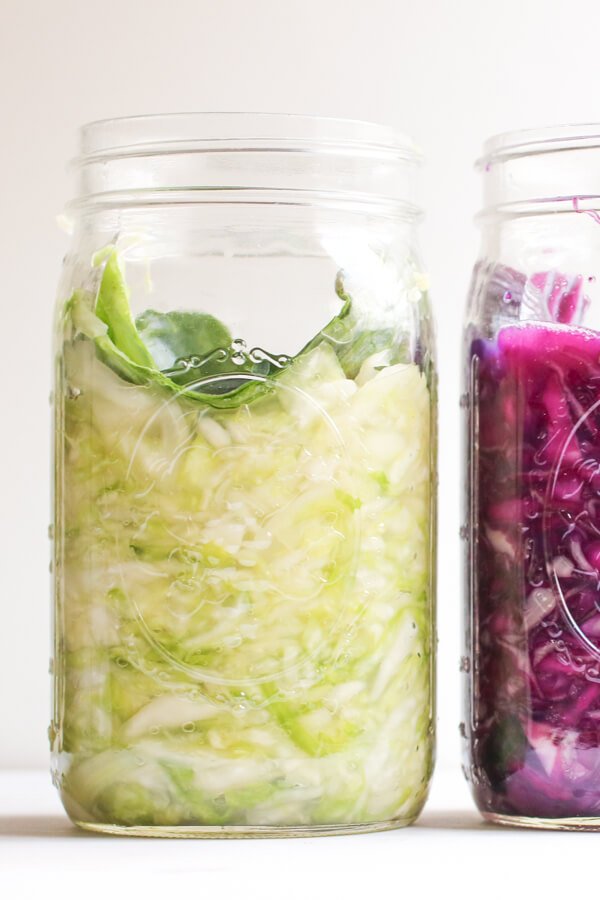Every winter, the humble cabbage starts to make more frequent appearances in my cooking rotation. One of my favorite cabbage recipes has gotta be braised cabbage, but I also love whipping up some sauerkraut! Making your own sauerkraut may seem daunting, but I like to think of sauerkraut as the gateway into fermentation… it’s quick to make, requires no special tools, and it is so gosh darn good for you + your gut. All you do is combine some freshly shredded cabbage with salt, pack it all into a jar, and then wait a few weeks! You can also certainly substitute other vegetables in place of cabbage… shredded carrots, beets, turnips, kohlrabi, etc would all work great too. Here’s my full recipe + method:
HOMEMADE SAUERKRAUT
INGREDIENTS + EQUIPMENT
1 medium head green or red cabbage (about 3 pounds)
1 1/2 tablespoons kosher salt
1 tablespoon caraway or fennel seeds (optional)
1 quart-sized wide mouth jar with lid
INSTRUCTIONS
Prepare jar: Wash your mason jar and lid in hot soapy water, rinse and let air dry.
Slice the cabbage: Discard any wilted, limp outer leaves of the cabbage. Cut the cabbage into quarters and trim out the core. Slice each quarter down its length, making 8 wedges. Slice each wedge crosswise into very thin ribbons.
Combine the cabbage and salt: Transfer the cabbage to a big mixing bowl and sprinkle the salt and caraway seeds over top. Work the salt and caraway or fennel seeds (if using) into the cabbage by massaging and squeezing the cabbage with your hands until it softens and releases liquid, 5-10 minutes.
Pack the cabbage: Grab handfuls of the cabbage and pack them into the canning jar. Pour any liquid released by the cabbage into the jar. Place one of the larger outer leaves of the cabbage over the surface of the sliced cabbage to keep the cabbage submerged in its liquid.
Cover the jar: Cover the mouth of the jar loosely with the lid, or with a cloth secured by a rubber band or twine.
Press the cabbage every few hours: Over the next 24 hours, press down on the cabbage every so often with a clean utensil. As the cabbage releases its liquid, it will become more limp and compact and the liquid will rise over the top of the cabbage.
Ferment the cabbage for 1-2 weeks: As it's fermenting, keep out at room temperature and make sure the brine always covers the cabbage. When the sauerkraut tastes great, refrigerate!
Storage: Sauerkraut is a fermented product, so it will keep for up to six months refrigerated.
ADDITIONAL NOTES:
Add extra liquid, if needed: It’s very important for the brine to cover the cabbage at all times. If extra brine is needed, dissolve 1 teaspoon of salt in 1 cup of water and add enough to submerge the cabbage.
Canning sauerkraut: You can process sauerkraut for longer storage outside of refrigeration, but the canning process will kill the good bacteria produced by the fermentation process.
Skimming: While the sauerkraut is fermenting, you may see bubbles, foam, or white scum. These are all signs of a healthy, happy fermentation process. The scum can be skimmed off the top either during fermentation or before refrigerating.

